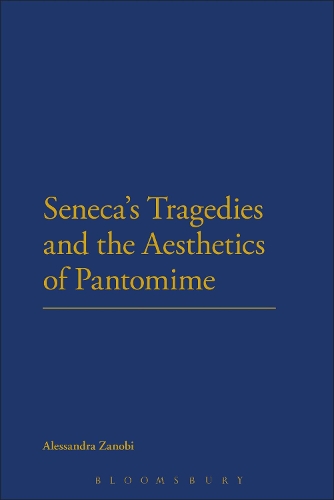
Seneca's Tragedies and the Aesthetics of Pantomime
(Hardback)
Available Formats
Publishing Details
Seneca's Tragedies and the Aesthetics of Pantomime
By (Author) Alessandra Zanobi
Bloomsbury Publishing PLC
Bloomsbury Academic
16th January 2014
United Kingdom
Classifications
Tertiary Education
Non Fiction
Ancient history
872.01
Physical Properties
Hardback
296
Width 156mm, Height 234mm
594g
Description
Pantomime was arguably the most popular dramatic genre during the Roman Empire, but has been relatively neglected by literary critics. Senecas Tragedies and the Aesthetics of Pantomime adds to our understanding of Seneca's tragic art by demonstrating that elements which have long puzzled scholars can be attributed to the influence of pantomime. The work argues that certain formal features which depart from the conventions of fifth-century Attic drama can be explained by the influence of, and interaction with, this more popular genre. The work includes a detailed and systematic analysis of the specific pantomime-inspired features of Senecas tragedies: the loose dramatic structure, the presence of running commentaries (minute descriptions of characters undergoing emotional strains or performing specific actions), of monologues of self-analysis, and of narrative set-pieces. Relevant to the culture of Roman imperial culture more generally, Senecas Tragedies and the Aesthetics of Pantomime includes an outline of the general features of pantomime as a genre. The work shows that the influence of sub-literary-genres such as pantomime and mime, the sister art of pantomime, can be traced in several Roman writers whose literary production was antecedent or contemporary with Senecas. Furthermore, the work sheds light on the interaction between sub-literary genres of a performative nature such as mime and pantomime and more literary ones, an aspect of Latin culture which previous scholarship has tended to overlook. Senecas Tragedies and the Aesthetics of Pantomime provides an original contribution to the understanding of the impact of pantomime on Roman literary culture and of controversial and little-understood features of Senecan tragedies.
Reviews
This monograph makes a valuable contribution to the study of Senecan drama in light of the recent revaluation of pantomime as a prominent component of imperial performance culture Zanobis study no doubt is of great interest to scholars of Roman performance culture and in particular specialists of Senecan drama, who will use it as a welcome aid especially when working closely on certain controversial passages. -- Karin Schlapbach * Bryn Mawr Classical Review *
The book is useful as a comprehensive guide to possible aspects of Senecan tragedy that may be indebted to the genre of pantomime such as running commentaries, descriptive narrative set-pieces, and monologues of self-analysis. -- Christopher Trinacity, Oberlin College * New England Classical Journal 41.4 *
There is certainly a great deal of research and thought involved in this book. The assemblage of ancient sources on mime and pantomime is impressive. The suggestions that pantomime had a conventional vocabulary of standard gestures and dance steps (throughout chapter 1) are intriguing, and invite further comparisons with other genres, such as classical Japanese and Sanskrit dramas. And the links to pantomime offer useful insights into non-dramatic Roman literature. -- Thomas D. Kohn, Wayne State University * Classical Journal *
Fully documented and carefully argued ... this publication is handsomely printed in a new series. * GNOMON *
Meticulous scholarship, combined with the authors own experience as a trained dancer, have produced the most exciting and original new study of Senecan drama of the 21st century. By placing the texts in the context of Roman imperial performance culturesung and danced rather than just recited or declaimedZanobi has revolutionized the way we think about these canonical tragic texts. -- Edith Hall, Professor of Classics, King's College London, UK
Seneca's Tragedies and the Aesthetics of Pantomime is a remarkable study of the use of mime and pantomime by elite writers of classical Rome. Zanobi's erudition is as deep as her range is wide. The book forces a reconsideration of longstanding assumptions about the relations between literature and other cultural practice and I recommend it to all students of Roman culture. -- Thomas Habinek, Department of Classics, University of Southern California, USA.
Alessandra Zanobis book offers a stimulating reassessment of the aesthetics of Senecas tragedy against the background of the danced drama of the pantomime that dominated the Roman stage in his day. By restoring this forgotten context, she breaks down the boundaries between high and popular culture in the Roman world and adds a new dimension, simultaneously corporeal and intensely imaginative, to Senecas plays. -- Ruth Webb, University of Lille 3, France
[Zanobi's] argument is both timely and persuasive ... * JRS *
Author Bio
Alessandra Zanobi is an Associate of the Archive of Performances of Greek and Roman Drama, University of Oxford, UK.
